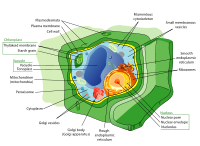- Cold hardening
-
Cold hardening is the physiological and biochemical process by which an organism prepares for cold weather.
Plants
During the winter months, as the leaves fall off deciduous species and the temperature drops, the cold forces a stop to water movement in plants. Freezing water can also cause irreversible damage to cells in plants as water solidifies. To guard against this, plants prepare for winter with a process called cold hardening. The process begins as the cell membrane permeability undergoes a change that permits water to seep into the intracellular voids. In addition, the cells store large amounts of sugars in the protoplasm, decreasing its freezing point.
Cold hardening protects plants from both chilling injury and freezing injury. Chilling injury occurs at 0-10 degrees Celsius, as a result of membrane damage, metabolic changes, and toxic buildup. Symptoms include wilting, water soaking, necrosis, chlorosis, ion leakage, and decreased growth. Freezing injury occurs at temperatures below 0 degrees Celsius. Symptoms of extracellular freezing include structural damage, dehydration, and necrosis. If intracellular freezing occurs, it will lead to death. Freezing injury is a result of lost permeability, plasmolysis, and post-thaw cell bursting.
See Also
- Hardening (botany)
- Cryobiology
Categories:- Physiology
- Ecology stubs
Wikimedia Foundation. 2010.

